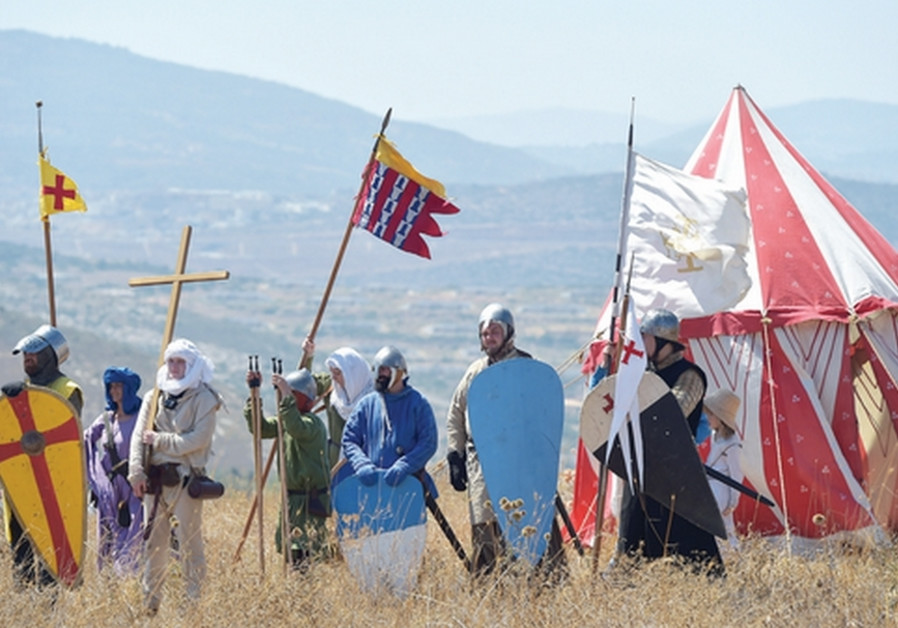
A GROUP of about 20 men take part in a three-day reenactment of the Battle of Hattin, which climaxed with the beheading of Raynald de Châtillon at Horns of Hattin, overlooking the Kinneret.. (photo credit: MEIR VAKNIN/FLASH90)
Posted on 09/21/2018 10:56:43 AM PDT by SJackson
About three years ago, I was shocked to learn that the Israeli government decided to establish a new town for the Druze community on the southern slopes of the Horns of Hattin National Park.
A GROUP of about 20 men take part in a three-day reenactment of the Battle of Hattin, which climaxed with the beheading of Raynald de Châtillon at Horns of Hattin, overlooking the Kinneret.. (photo credit: MEIR VAKNIN/FLASH90)
bout three years ago, I was shocked to learn that the Israeli government decided to establish a new town for the Druze community on the southern slopes of the Horns of Hattin National Park. On the 4th of July 1187, the Frankish (Crusader) forces suffered a decisive defeat at the hands of the Muslims by the volcanic hill known as the “Horns of Hattin” (in the eastern Lower Galilee).
About three years ago, I was shocked to learn that the Israeli government decided to establish a new town for the Druze community on the southern slopes of the Horns of Hattin National Park. A few days ago this development program was officially approved. This act will have devastating implications for this important historical site.
As an archaeologist practicing landscape and conflicts archaeology, I have been studying the landscape of Hattin for over 11 years. Apart from the famous Battle of Hattin, the fields of Hattin had witnessed other conflicts, among them Napoleon’s Battle of Nazareth (April 1799), a battle between Bedouin and Othman cavalry (March 1857), and a battle from the Israeli Independence War (July 1948). In addition to the archaeological remains, the landscape of Hattin preserved the “memory” of some of the historical events which took place in it, when specific fields were still called by the local Arab names after events and even individuals which played part in those events.
The Hattin landscape also attracted human activity of non-violent character. The landscape is rich in archaeological sites and features of different types, from as early as the Middle Paleolithic (250,000- 50,000 before present) to our modern era. The area where the new city is intended to be built had remained unchanged for more than 1,800 years and resembles a window into the past.
This unique landscape includes archaeological sites such as a Middle Paleolithic flint quarry; Late Bronze Age and Iron Age settlements, sanctuaries, and tombs; an extensive Late Roman road system and a unique field system from the same period as well as a number of industrial and agricultural installations related to it.
The Horns of Hattin is identified by some Christian communities as the Mount of Beatitudes, where the Sermon on the Mount took place. In fact, until the 1930s, most of the Christian pilgrimage interested in Mount Beatitudes was directed to the Horns of Hattin and not to the current location. In addition, the battlefield of Hattin is where the relic of the “True Cross” was supposedly lost during the Battle of Hattin, never to return to Christian hands. All of these archaeological sites (and others) give the Hattin landscape its unique character, which is composed of numerous and diverse layers of natural and cultural elements that must be preserved for future generations.
Throughout the long human duration it was common practice for one ruler to remove the memory of his predecessor by bringing down past monuments or by crediting himself to them. Can we behave in a noble (not to say mature) manner? Can we overcome our brutal need to emphasis our “own” cultural heritage by wiping out the Hattin landscape and its memory? As Israeli citizens, we are entitled to protect and cherish the heritage of all the land’s cultures. The Druze community should have the right to flourish and develop just like any other community in this country, but should it be on the expense of this landscape?
These development plans must be stopped before they devastate the important cultural sites that reflect the cultural diversity of the Holy Land.
If you’d like to be on or off, please FR mail me.
..................
In that country you will stumble over history every time you take a step. Nothing could happen if you can’t build or develop anything.
That reminds me, I need to go to the Horns of Hattin
Walmart and pick up a few things.
Muslim, yes. Arab, no.
Saladin was a Kurd.
I thought he was a Kurd, but you’re correct, not an Arab.
Rethinking, Kurds are from Persia. Probably could be described as Persian.
That’s true. I found the existance of reinactors interesting.
When Persia was Persia, there would be a lot of separate races that didn’t exist at that period if all were Persians.
Actually, the Kurds are the descendants of the ancient Medes.
Salidin as a Kurd.......I read it definitively on Free Republic.
Disclaimer: Opinions posted on Free Republic are those of the individual posters and do not necessarily represent the opinion of Free Republic or its management. All materials posted herein are protected by copyright law and the exemption for fair use of copyrighted works.